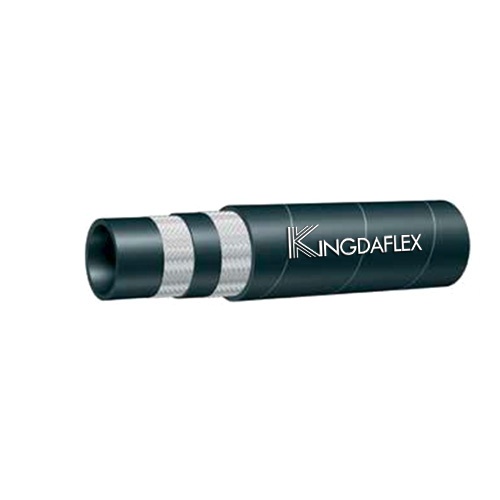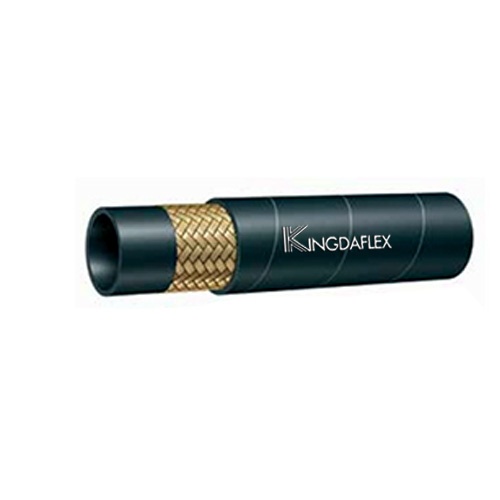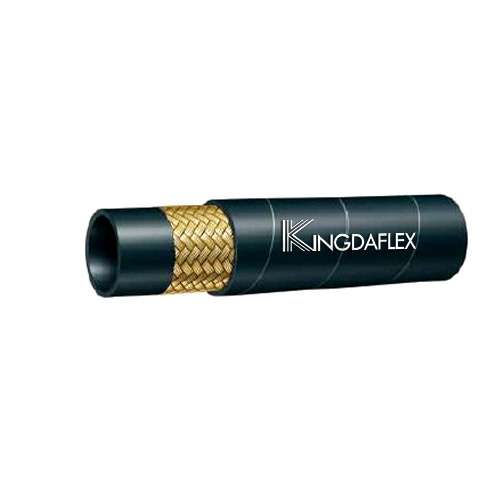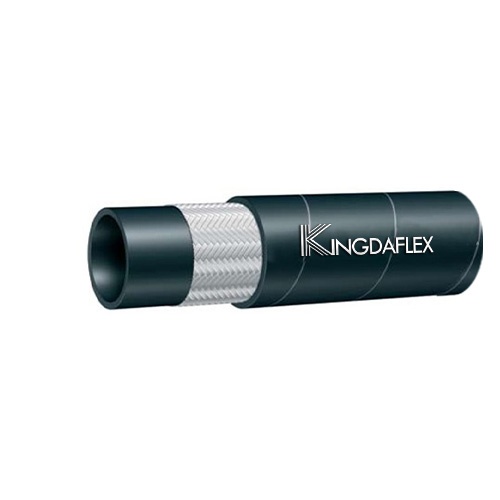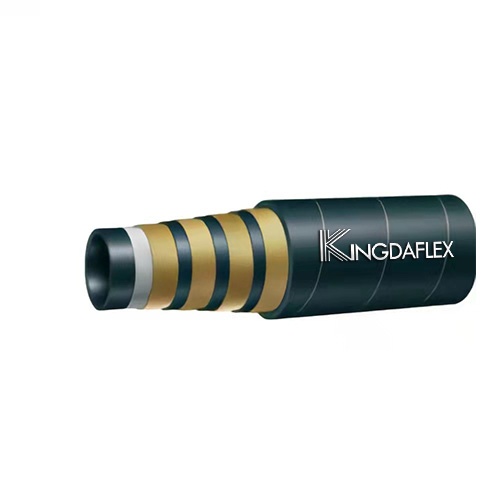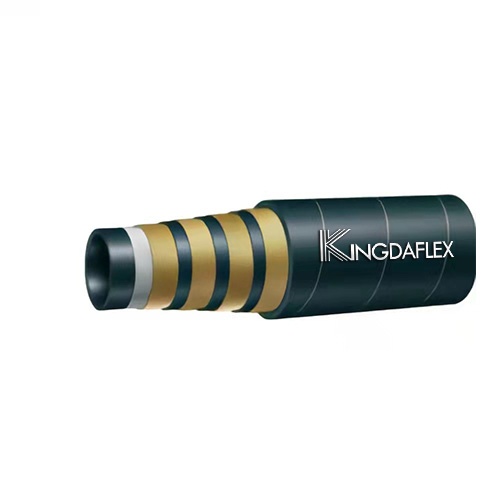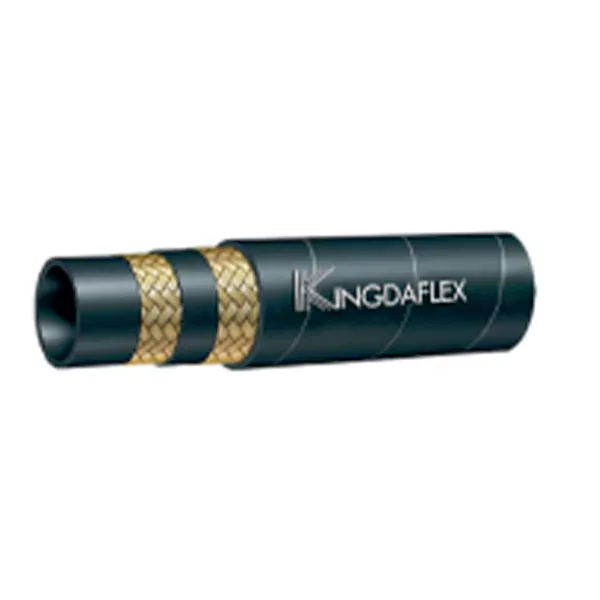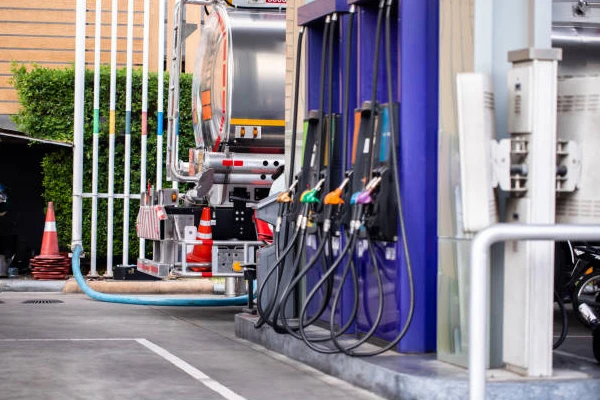Hydraulic hoses are essential components in various industrial applications, playing a crucial role in fluid transfer under high pressure. Understanding the different types of hydraulic hoses is vital for selecting the right one for specific needs. This blog will explore the various types of hydraulic hoses, their unique characteristics, and their applications.
We’ll delve into the construction, materials, and performance specifications of each hose type, providing you with the knowledge to make informed decisions. Whether you’re working in construction, agriculture, or manufacturing, this guide will help you navigate the complexities of hydraulic hose selection and ensure optimal system performance.What Are Hydraulic Hoses?

Hydraulic hoses are flexible tubes made of synthetic rubber, thermoplastic material, or Teflon. They are used to transmit hydraulic fluid from one component to another in a hydraulic system. The fluid can be oil, water, or a mixture of both. Hydraulic hoses are used in various applications, including construction, mining, agriculture, and industrial machinery.
Types of Hydraulic Hoses
Understanding the various types of hydraulic hoses is crucial for selecting the right hose for specific applications, ensuring optimal performance and safety in hydraulic systems. Each type offers unique characteristics tailored to different pressure, temperature, and fluid compatibility requirements. We’ll explore the main types of hydraulic hoses, their features, benefits, and applications.
Rubber Hydraulic Hoses
Rubber hydraulic hoses are a traditional and versatile choice for many hydraulic applications. They are constructed with a synthetic rubber inner tube, reinforcement layers (typically steel wire braids or spirals), and a synthetic rubber outer cover. Features include excellent flexibility, good abrasion resistance, and the ability to handle a wide range of hydraulic fluids. Benefits include ease of installation, cost-effectiveness, and reliable performance in moderate to high-pressure systems.
These hoses are widely used in construction, agriculture, and industrial machinery. Applications include hydraulic power steering, fluid transfer in heavy equipment, and general-purpose hydraulic systems. Their flexibility allows for easy routing in complex machinery, while their robust construction ensures durability in harsh environments. Rubber hoses offer a balance of performance and affordability, making them a popular choice for various hydraulic applications.
The synthetic rubbers used in these hoses are selected for their compatibility with hydraulic fluids and their ability to withstand temperature variations. The reinforcement layers provide the necessary strength to handle high pressures, while the outer cover protects the hose from abrasion, weathering, and chemical exposure. Proper selection of rubber hydraulic hoses ensures efficient and reliable hydraulic system operation.
Thermoplastic Hydraulic Hoses
Thermoplastic hydraulic hoses are designed for applications where flexibility, lightweight construction, and non-conductivity are essential. They are constructed with a thermoplastic inner tube, synthetic fiber reinforcement, and a thermoplastic outer cover. Features include high flexibility, low volumetric expansion, and resistance to chemical degradation. Benefits include easy handling, clean fluid transfer, and suitability for applications with tight bend radii.
These hoses are commonly used in applications such as hydraulic tools, lubrication systems, and chemical transfer. Their lightweight and flexible design makes them ideal for portable equipment and applications with limited space. The non-conductive properties of thermoplastic hoses are crucial in electrical environments, preventing electrical hazards.
Thermoplastic materials like polyurethane and nylon provide excellent chemical resistance and low volumetric expansion, ensuring consistent fluid flow and pressure transmission. The synthetic fiber reinforcement enhances the hose’s strength and pressure rating while maintaining flexibility. These hoses are designed to provide clean and efficient fluid transfer, minimizing contamination and ensuring system reliability.
Teflon Hydraulic Hoses
Teflon (PTFE) hydraulic hoses are engineered for extreme temperature and chemical resistance, making them ideal for specialized applications. They are constructed with a PTFE inner tube, stainless steel wire braid reinforcement, and an optional outer cover. Features include wide temperature range (-65°F to 450°F), excellent chemical compatibility, and low coefficient of friction. Benefits include reliable performance in harsh environments, long service life, and minimal fluid contamination.
These hoses are used in applications such as chemical processing, high-temperature hydraulic systems, and food and pharmaceutical industries. Their chemical inertness ensures compatibility with a wide range of fluids, including corrosive chemicals and high-purity substances. The smooth inner surface minimizes fluid friction and prevents buildup, ensuring clean and efficient fluid transfer.
The stainless steel wire braid reinforcement provides the necessary strength to handle high pressures, while the PTFE inner tube maintains its properties under extreme temperature conditions. Teflon hoses are designed for applications where reliability and chemical resistance are paramount, ensuring safe and efficient fluid transfer in demanding environments.
Hybrid Hydraulic Hoses
Hybrid hydraulic hoses combine the benefits of rubber and thermoplastic hoses, offering a versatile solution for various hydraulic applications. They typically feature a thermoplastic inner tube, multiple layers of reinforcement (combining steel wire and synthetic fibers), and a rubber outer cover. Features include high flexibility, good pressure ratings, and improved chemical resistance compared to standard rubber hoses. Benefits include reduced weight, enhanced durability, and suitability for applications requiring both flexibility and high-pressure capabilities.
These hoses are increasingly used in applications such as mobile hydraulics, industrial machinery, and automotive systems. Their hybrid construction provides a balance of performance characteristics, making them suitable for a wide range of operating conditions. The combination of materials ensures that the hoses can handle both high pressures and demanding environmental factors.
The thermoplastic inner tube offers excellent fluid compatibility and low volumetric expansion, while the reinforcement layers provide the necessary strength and flexibility. The rubber outer cover protects the hose from abrasion, weathering, and chemical exposure, ensuring long service life. Hybrid hoses are designed to provide reliable and efficient fluid transfer, minimizing downtime and maintenance costs.
Hydraulic Hose Types Classified by Reinforcement
Understanding hydraulic hose types by reinforcement is crucial for selecting the right hose for specific applications, ensuring optimal performance and safety. Each reinforcement material offers unique characteristics tailored to different pressure, temperature, and application requirements. We’ll explore the main types of hydraulic hoses, classified by reinforcement, their features, benefits, and applications.
Wire Braid Reinforced Hydraulic Hoses
Wire braid reinforced hydraulic hoses are a common choice for medium to high-pressure hydraulic systems. They feature one or two layers of braided steel wire reinforcement over a synthetic rubber inner tube, providing excellent strength and flexibility. Features include high-pressure resistance, good flexibility, and durability in various operating conditions. Benefits include reliable performance, ease of installation, and cost-effectiveness for many applications.
These hoses are widely used in construction, agriculture, and industrial machinery. Applications include hydraulic power steering, fluid transfer in heavy equipment, and general-purpose hydraulic systems. Their braided construction allows for flexibility in routing while maintaining high-pressure integrity. The steel wire reinforcement ensures the hose can withstand demanding conditions and prevent bursts or leaks.
The number of wire braid layers determines the hose’s pressure rating, with more layers providing higher pressure resistance. The synthetic rubber inner tube ensures compatibility with hydraulic fluids and withstands temperature variations. The outer cover protects the reinforcement from abrasion and environmental damage, ensuring a long service life.
Wire Spiral Reinforced Hydraulic Hoses
Wire spiral reinforced hydraulic hoses are designed for extremely high-pressure applications, such as heavy-duty construction and mining equipment. They feature multiple layers of spiraled steel wire reinforcement, providing exceptional strength and pressure resistance. Features include ultra-high-pressure capabilities, robust construction, and excellent resistance to impulse fatigue. Benefits include reliable performance in demanding environments, minimal volumetric expansion, and long service life under extreme conditions.
These hoses are commonly used in applications such as hydraulic presses, heavy construction equipment, and mining machinery. The spiraled wire layers provide superior strength and prevent hose expansion under high pressure. The robust construction ensures the hose can withstand the harsh conditions of heavy-duty industrial applications.
The spiraled wire reinforcement pattern distributes pressure evenly across the hose, minimizing stress and preventing premature failure. The synthetic rubber inner tube and outer cover are designed to withstand high temperatures and abrasive environments, ensuring consistent performance and longevity. These hoses are engineered for applications where safety and reliability are paramount.
Textile Reinforced Hydraulic Hoses
Textile reinforced hydraulic hoses are designed for low to medium-pressure applications where flexibility and lightweight construction are essential. They feature one or more layers of textile fiber reinforcement, such as synthetic yarn or fabric, over a thermoplastic or rubber inner tube. Features include high flexibility, lightweight design, and good chemical resistance. Benefits include easy handling, cost-effectiveness, and suitability for applications with tight bend radii.
These hoses are commonly used in applications such as pneumatic tools, lubrication systems, and light-duty hydraulic systems. Their flexibility and lightweight design make them ideal for portable equipment and applications with limited space. The textile reinforcement provides adequate strength for low to medium-pressure applications while maintaining flexibility.
The textile fibers used in these hoses are selected for their strength and resistance to chemical degradation. The thermoplastic or rubber inner tube ensures compatibility with hydraulic fluids and provides a smooth surface for fluid flow. The outer cover protects the reinforcement from abrasion and environmental factors, ensuring a long service life. These hoses offer a cost-effective solution for applications where high-pressure resistance is not required.
Hydraulic Hose Types Classified by Number of Layers
Understanding the various types of hydraulic hoses, classified by their reinforcement layers, is crucial for selecting the right hose for specific applications, ensuring optimal performance and safety in hydraulic systems. Each reinforcement configuration offers unique characteristics tailored to different pressure, temperature, and fluid compatibility requirements. We’ll explore the main types of hydraulic hoses based on their reinforcement layers, their features, benefits, and applications.
Single Wire Braid Hydraulic Hoses
Single wire braid hydraulic hoses are constructed with a single layer of steel wire braid reinforcement over the inner tube. Features include moderate pressure ratings, good flexibility, and cost-effectiveness. Benefits include ease of installation, suitability for general-purpose applications, and reliable performance in medium-pressure systems. These hoses are commonly used in applications such as hydraulic tools, light-duty machinery, and general industrial equipment.
Their single wire braid layer provides sufficient strength for moderate pressure applications while maintaining flexibility for easy routing. The synthetic rubber inner tube and outer cover ensure compatibility with hydraulic fluids and protection against abrasion and weathering. Single wire braid hoses offer a balance of performance and affordability, making them a popular choice for various hydraulic systems.
These hoses are ideal for applications where flexibility and moderate pressure resistance are essential. Their lightweight construction and ease of handling make them suitable for portable equipment and installations with limited space. Proper selection ensures efficient fluid transfer and reliable performance in medium-pressure environments.
Double Wire Braid Hydraulic Hoses
Double wire braid hydraulic hoses feature two layers of steel wire braid reinforcement, providing increased pressure ratings and durability. Features include higher pressure resistance, improved abrasion resistance, and enhanced structural integrity. Benefits include reliable performance in high-pressure systems, extended service life, and suitability for demanding applications. These hoses are commonly used in heavy machinery, construction equipment, and industrial hydraulic systems.
The double wire braid reinforcement layers provide superior strength and pressure containment, allowing these hoses to handle higher operating pressures compared to single wire braid hoses. The robust construction ensures durability in harsh environments, while the synthetic rubber inner tube and outer cover provide fluid compatibility and protection against external factors. Double wire braid hoses offer a balance of high-pressure performance and durability.
These hoses are ideal for applications where high pressure and demanding operating conditions are present. Their robust construction and reliable performance make them essential for heavy-duty hydraulic systems, ensuring efficient fluid transfer and minimizing downtime.
Spiral Wire Hydraulic Hoses
Spiral wire hydraulic hoses are designed for extreme high-pressure applications, featuring multiple layers of spiral-wound steel wire reinforcement. Features include very high-pressure ratings, exceptional strength, and minimal volumetric expansion. Benefits include reliable performance in severe operating conditions, extended service life, and suitability for demanding applications with high impulse pressures. These hoses are commonly used in heavy-duty construction equipment, mining machinery, and offshore drilling operations.
The spiral wire reinforcement layers provide exceptional strength and pressure containment, allowing these hoses to handle the most demanding hydraulic applications. The robust construction minimizes volumetric expansion and ensures consistent fluid flow under extreme pressures. The synthetic rubber inner tube and outer cover provide fluid compatibility and protection against harsh environments. Spiral wire hoses are engineered for applications where reliability and performance are paramount.
These hydraulic hoses are ideal for applications where extreme pressure and severe operating conditions are present. Their robust construction and exceptional strength make them essential for heavy-duty hydraulic systems, ensuring safe and efficient fluid transfer in the most demanding environments.
Hydraulic Hose Types Classified by Pressure Ratings
Understanding hydraulic hose types classified by pressure ratings is crucial for selecting the right hose for specific applications, ensuring optimal performance and safety in hydraulic systems. Each pressure rating category offers unique characteristics tailored to different operational demands. We’ll explore the main types of hydraulic hoses based on their pressure ratings, their features, benefits, and applications.
Low-Pressure Hydraulic Hoses
Low-pressure hydraulic hoses are designed for applications with operating pressures up to 300 PSI. Features include flexible construction, lightweight design, and suitability for low-pressure fluid transfer. Benefits include easy installation, cost-effectiveness, and reliable performance in light-duty applications. These hoses are commonly used in air tools, lubrication systems, and low-pressure hydraulic circuits.
Their construction typically includes a synthetic rubber or thermoplastic inner tube, textile or wire braid reinforcement, and a synthetic rubber or thermoplastic outer cover. The flexible design allows for easy routing and installation in confined spaces. Low-pressure hoses are ideal for applications where flexibility and cost-effectiveness are prioritized.
These hoses are suitable for applications where minimal pressure is required, ensuring efficient fluid transfer without compromising system integrity. Their lightweight construction and easy handling make them ideal for portable equipment and light-duty industrial applications.
Medium-Pressure Hydraulic Hoses
Medium-pressure hydraulic hoses are designed for applications with operating pressures ranging from 300 PSI to 3,000 PSI. Features include moderate flexibility, robust construction, and suitability for a wide range of hydraulic fluids. Benefits include reliable performance in general-purpose hydraulic systems, good abrasion resistance, and extended service life. These hoses are commonly used in construction equipment, agricultural machinery, and industrial hydraulic systems.
Their construction typically includes a synthetic rubber inner tube, single or double wire braid reinforcement, and a synthetic rubber outer cover. The wire braid reinforcement provides sufficient strength for medium-pressure applications while maintaining flexibility for easy routing. Medium-pressure hoses offer a balance of performance and durability.
These hoses are ideal for applications where moderate pressure and demanding operating conditions are present. Their robust construction and reliable performance make them essential for general-purpose hydraulic systems, ensuring efficient fluid transfer and minimizing downtime.
High-Pressure Hydraulic Hoses
High-pressure hydraulic hoses are designed for applications with operating pressures exceeding 3,000 PSI.
Features include robust construction, high-tensile steel wire reinforcement, and minimal volumetric expansion. Benefits include reliable performance in extreme operating conditions, extended service life, and suitability for demanding applications with high impulse pressures. These hoses are commonly used in heavy-duty construction equipment, mining machinery, and offshore drilling operations.
Their construction typically includes a synthetic rubber inner tube, multiple layers of spiral-wound steel wire reinforcement, and a synthetic rubber outer cover. The spiral wire reinforcement provides exceptional strength and pressure containment, allowing these hoses to handle the most demanding hydraulic applications. High-pressure hoses are engineered for applications where reliability and performance are paramount.
These hydraulic hoses are ideal for applications where extreme pressure and severe operating conditions are present. Their robust construction and exceptional strength make them essential for heavy-duty hydraulic systems, ensuring safe and efficient fluid transfer in the most demanding environments.
Hydraulic Hose Types Classified by Standards
Understanding hydraulic hose types classified by industry standards is crucial for ensuring compatibility, safety, and optimal performance in hydraulic systems. These standards provide specific guidelines for construction, performance, and testing, guaranteeing reliability across diverse applications. We’ll explore the main types of hydraulic hoses based on prevalent industry standards, their features, benefits, and applications.
SAE Standard Hydraulic Hoses
SAE (Society of Automotive Engineers) standard hydraulic hoses are widely recognized and used across various industries.
Features include standardized dimensions, pressure ratings, and performance specifications. Benefits include interchangeability, reliable performance, and adherence to industry best practices. These hoses are commonly used in automotive, construction, agriculture, and industrial applications.
SAE standards, such as SAE J517, define the requirements for various types of hydraulic hoses, including wire braid and spiral wire reinforced hoses. These standards ensure consistent quality and performance, allowing for easy selection and replacement. SAE hoses are designed to meet specific pressure and temperature requirements, ensuring safe and efficient fluid transfer.
These hoses are ideal for applications where standardized performance and compatibility are essential. Their widespread adoption and adherence to industry standards make them a reliable choice for various hydraulic systems.
DIN Standard Hydraulic Hoses
DIN (Deutsches Institut für Normung) standard hydraulic hoses are commonly used in European and international markets. Features include metric dimensions, high-pressure ratings, and robust construction. Benefits include reliable performance in demanding applications, adherence to international standards, and compatibility with European machinery. These hoses are commonly used in industrial machinery, heavy equipment, and hydraulic systems designed to DIN specifications.
DIN standards, such as DIN EN 853 and DIN EN 856, specify the requirements for various types of hydraulic hoses, including wire braid and spiral wire reinforced hoses. These standards ensure consistent quality and performance, particularly in high-pressure applications. DIN hoses are designed to meet specific metric dimensions and performance requirements, ensuring compatibility with European machinery.
These hoses are ideal for applications where adherence to DIN standards and compatibility with European machinery are essential. Their robust construction and high-pressure ratings make them suitable for demanding industrial applications.
ISO Standard Hydraulic Hoses
ISO (International Organization for Standardization) standard hydraulic hoses are designed for global compatibility and performance.
Features include internationally recognized standards, diverse pressure ratings, and versatile applications. Benefits include global interchangeability, reliable performance in various environments, and adherence to international best practices. These hoses are commonly used in a wide range of industries, including construction, agriculture, and manufacturing.
ISO standards, such as ISO 18752 and ISO 3862, provide specifications for various types of hydraulic hoses, including wire braid and spiral wire reinforced hoses. These standards ensure consistent quality and performance, facilitating international trade and ensuring global compatibility. ISO hoses are designed to meet diverse pressure and temperature requirements, ensuring reliable performance in various environments.
These hoses are ideal for applications where global interchangeability and adherence to international standards are essential. Their versatile applications and reliable performance make them a preferred choice for various hydraulic systems worldwide.
Conclusion
In conclusion, understanding the various types of hydraulic hoses is essential for selecting the right hose for specific applications. Each type, from rubber to thermoplastic, offers unique characteristics tailored to different pressure, temperature, and fluid compatibility requirements. Proper selection ensures optimal performance, safety, and longevity of hydraulic systems.
By considering factors like reinforcement materials, flexibility, and environmental conditions, users can make informed decisions that minimize downtime and prevent costly failures. This comprehensive knowledge empowers industries to maintain efficient and reliable hydraulic operations, enhancing overall productivity.
For a wide range of high-quality wholesale hydraulic hoses that meet diverse industrial needs, choose Kingdaflex. We offer expert guidance and competitive pricing to ensure you get the best solutions for your hydraulic systems. Contact us today to receive a personalized quote and elevate your operational efficiency.

